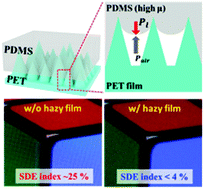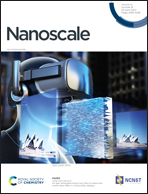Air-gap-embedded robust hazy films to reduce the screen-door effect in virtual reality displays†
Abstract
We report a way to make an air-gap-embedded flexible film to reduce the screen-door effect (SDE) in virtual reality (VR) displays. Oxygen plasma was treated with a polyethylene terephthalate substrate to produce wavelength-scale micropatterns. These micropatterns induce an effective haze, but it is easily destroyed by a very small external scratch. Such a problem could be solved by coating the patterns with poly(dimethylsiloxane) (PDMS). The viscosity of PDMS, controlled by the ratio of the base and curing agents, plays a key role in determining the size of air-gaps at the valleys of micropatterns. As the ratio of base agent increases to 40, the average haze abruptly increased from 0.9% to 88.6% in visible wavelengths, while the average total transmittance maintained was between 89.8 and 91.7%. The origin of air-gap-induced haze is confirmed by numerical simulations. The hazy film remarkably reduced the SDE of the VR display from 30.27% to 4.83% for red color, from 21.82% to 2.58% for green, and from 26.02% to 3.38% for blue, as the size of air-gaps increases from 0 to 406 ± 91 nm. No defects were found after 10 000 bending cycles with a bending radius of 3 mm.



 Please wait while we load your content...
Please wait while we load your content...